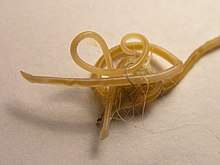Cat worm infections, the infection of cats (Felidae) with parasitic worms, occur frequently. Most worm species occur worldwide in both domestic and other cats, but there are regional, species and lifestyle differences in the frequency of infestation. According to the classification of the corresponding parasites in the zoological system, infections can be divided into those caused by nematode and flatworms - in the case of the latter, mainly cestoda and trematoda - while other strains are of no veterinary significance. While threadworms usually do not require an intermediate host for their reproduction, the development cycle of flatworms always proceeds via alternate hosts.
As predators, cats are the final host for most worms. As so-called endoparasites ("internal parasites"), the worms colonize various internal organs, but usually cause no or only minor symptoms of disease. The infection therefore does not necessarily have to manifest itself in a worm infection (helminthosis). For most parasites, infection can be detected by examining feces for eggs or larvae. Some worms found in cats can also be transmitted to humans and are therefore zoonotic pathogens. Of greater importance here are the feline toxocara mystax and the fox tapeworm. Especially such worm infections should be controlled by regular deworming of cats living in close contact with humans.
